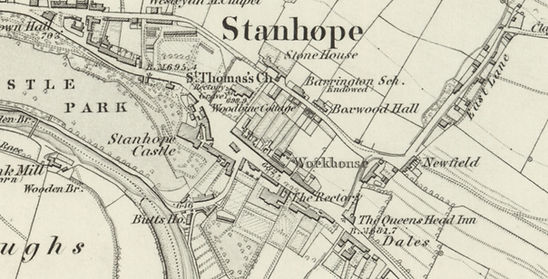
Stanhope
The Phoenix Inn (The Bonny Moorhen)
Last Updated:
3 Sept 2025
Stanhope
This is a
Pub
54.747344, -2.006374
Founded in
Current status is
Extant
Designer (if known):

Grade II listed
Continuing at the wet and windy Stanhope, this is the Bonny Moorhen - previously known as the Phoenix Inn. As is much of Stanhope this is a listed inn, "apparently" dating from the late 18th century with adjacent outhouses and stables from the early 19th century. They can be seen on the left of my shot.
It's quite an interesting building though isn't it? It's Georgian in its most angular and stoic but is incredibly plain and austere. Quite surprising given the opulence of this place.
There are varying stories about this inn, as it may well have been reconstructed after the 1820s. It was previously the site of the Black Bull Inn, a coaching house which was reputedly burnt down in 1818. This is a myth however, as newspaper archives document a Black Bull in use in 1826 for a Burns supper. Therefore, it's possible a fire occurred after and was rebuilt, hence the name The Phoenix. This rebuilt hotel's success will certainly have coincided with the Stanhope & Tyne though, when the village was comparatively far easier to reach from the outside world. Lodgings and accommodation was needed for those working at the ever expanding quarries and the foot of the railroad.
In fact, auctions were held here in the 1840s to sell these estates and lead mines. By 1846 it was put up for let, and the inn in occupation by Mr Jacob Crawhall featured a range of facilities. 3 sitting rooms, a dining room, 2 kitchens, a bar and pantry, a coach and brew house (to make their own ales), decent stabling and a yard. It's noted at this time it had recently been rebuilt (but perhaps substantially realtered), and had some a great trade in recent years. It certainly remained a meeting space of importance as nearly every auction, inquest and society meeting was held here into the mid 20th century.
By the 1960s the Phoenix was a Cameron's Pub. More recently though its name was changed to the Bonny Moorhen, in reference to a tale from 1818 when lead miners rose up against the Prince Bishop to allow them the right to hunt game. The Bonny Moorhen was a poem written by Thomas Couldon to celebrate the bravery of the starving men.
Listing Description (if available)


Both these Ordnance Survey maps illustrate Stanhope Market Square from the mid to the late 19th century. Though the castle and church were just as important in settling this site, the market was the engine for the village's growth and became the bread basket of Weardale. The Phoenix as it was then known stood on the north side of the square alongside St Thomas' which is likely the earliest building in the settlement. Change is fairly marginal throughout the decades, with new dwellings filling in the gaps, such as those on Chapel Street. The industrial workers settled in the extremities of the village, with the west end featuring a couple of rows and the east end extending the main lane.

There's a little bit more "filling in the gaps" through to the 1920s, with plenty of industrial activity still occurring in these parts. The huge limestone quarries north of the villages were operating alongside those on the other side of the river. Just out of view are the remains of the Shittlehope Burn Prisoner of War Camp, which was still intact some years later having also worked at the quarries during the war.

The Phoenix, now the Bonny Moorhen, at Stanhope looking east in July 2025.

Under the guise of the Phoenix Hotel in this postcard from the early 20th century. Daley's Grocer has been demolished. Unknown original source.
